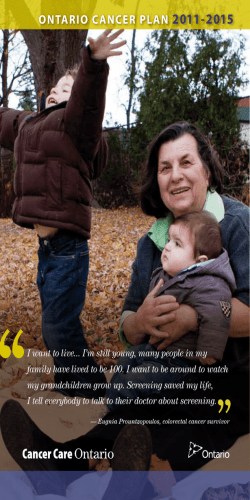
Patients First: Action Plan for Health Care
RM PROT ECT INFO CON N ACCE SS ECT Patients First: Action Plan for Health Care February 2015 Ministry of Health and Long-Term Care Office of the Minister 10th Floor, Hepburn Block 80 Grosvenor Street Toronto ON M7A 2C4 Tel. 416 327-4300 Fax 416 326-1571 www.ontario.ca/health Ministère de la Santé et des Soins de longue durée Bureau du ministre Édifice Hepburn, 10e étage 80, rue Grosvenor Toronto ON M7A 2C4 Tél. 416 327-4300 Téléc. 416 326-1571 www.ontario.ca/sante Message from the Minister of Health and Long-Term Care Patients First: Ontario’s Action Plan for Health Care is the next phase of our government’s commitment to transform our health care system into one that puts the needs of patients at its centre. We’re building on a strong foundation laid by the first Action Plan for Health Care in 2012. And that plan has led to a number of important successes. But we know there’s still more work to do to improve the patient experience, to make our system more transparent, accountable and to ensure that our universal health care system will be there when we need it for generations to come. Our plan is called “Patients First” because caring for people is what motivates everyone in the health care sector, from doctors and nurses to administrators and personal support workers. The desire to improve people’s lives was at the core of why we chose this vocation and it must be at the core of every decision we make as a health system. Who we are and what we stand for as a society that values human life, that believes in dignity and respect for all...these are essential not only to health, but to the health care sector as a whole. A commitment to equity and access and universality – these are not just lofty ideals; these are principles worth striving for and defending always. We have to approach the challenges facing health care from a different vantage point, which is that if we believe in such rights to health and health care – as we do – then the questions we really should be asking ourselves are how do we ensure universality, improve access and deliver the highest quality of care? Yes, there are economic and demographic realities. And we will not hide from them. Our population is aging. Our financial resources are finite. But these are not insurmountable challenges. It is simply a matter of choices. Our choices must be rooted in evidence and patient experience. Our choices must put patients first. Because doing a better job in 2 health care means understanding and predicting the needs of Ontarians, and supporting models that best serve them. Every decision I have made, and our government will make, is centred on those principles. And this is the plan that will help us reach the ambitious but achievable goals we have set for ourselves and for patients. It will not be easy, but people and providers in all communities and all corners of our vast health care system have our commitment that we will work with you to deliver on our core promise: a health care system that puts patients first. Sincerely, Dr. Eric Hoskins Minister 3 Patients First: Action Plan for Health Care The Patients First: Action Plan for Health Care strengthens our commitment to put people and patients first by improving the health care experience. This next phase builds on the progress of our 2012 Action Plan for Health Care. Ontarians will have better and faster access to quality health services. They will have better information so they can make decisions that will help them live healthy and stay healthy. And their health care services will be protected for generations to come. Putting patients first • Support Ontarians to make healthier choices and help prevent disease and illness. • Engage Ontarians on health care, so we fully understand their needs and concerns. • Focus on people, not just their illness. • Provide care that is coordinated and integrated, so a patient can get the right care from the right providers. • Help patients understand how the system works, so they can find the care they need when and where they need it. • Make decisions that are informed by patients, so they play a major role in affecting system change. • Be more transparent in health care, so Ontarians can make informed choices. Building On Our Success Together, Ontarians have made enormous strides to improve health care in Ontario. Front-line health care workers, including personal support workers, nurses and doctors work tirelessly every day to make Ontario the healthiest place to grow up and grow old. Health care administrators and others behind the scenes are also making a big difference in caring for people who are sick or injured and keeping Ontarians healthy. When we launched our Action Plan for Health Care in 2012 we knew that: • • • • 4 Ontarians were not as healthy as they could be. Patients needed faster access to family health care. Patients were having difficulty getting care when and where they needed it. For patients treated by different providers, their care sometimes lacked coordination. We also knew that we had to find smarter ways to deliver health care. Fiscal realities meant managing health care spending was, and continues to be, a priority. And our province is faced with the additional challenge of an aging population with increasingly complex health care needs. The 2012 Action Plan set a new course. It helped us move from a fragmented system with growing costs to a system that is firmly focused on access, quality and value. Everyone working in the health care system has been front and centre in identifying opportunities and implementing positive changes. From our Local Health Integrated Networks to agencies like Cancer Care Ontario and Health Quality Ontario, to hospitals like Kingston General with its Patient Advisory Council, and innovative health care providers like Dr. Russell Goldman and his award winning work on palliative care, they have been instrumental in helping to change the system to better address health care challenges. Together, we have laid the foundation for a more sustainable health care system that focuses more on patient needs and improving the quality of care. Putting Patients First Working together, we have made many advances in health care. But we know there is more work to do. Patients First is our government’s blueprint for the next phase of health care system transformation. This plan is designed to deliver on one clear health promise – to put people and patients first by improving their health care experience and their health outcomes. This plan focuses on four key objectives: Access: Improve access – providing faster access to the right care. Connect: Connect services – delivering better coordinated and integrated care in the community, closer to home. Inform: Support people and patients – providing the education, information and transparency they need to make the right decisions about their health. Protect: Protect our universal public health care system – making decisions based on value and quality, to sustain the system for generations to come. 5 Patients First: Action Plan for Health Care Access Connect Improve access – providing faster access to the right care Connect services – delivering better coordinated and integrated care in the community, closer to home • More same day and next day visits to family doctors or primary care providers • Transforming home and community care • Seeing a specialist sooner • • Providing the right care for mental health and addiction More rehabilitation therapy for seniors • • Improving dementia support Inspections of long-term care homes • Expanding scope/removing barriers to full practice • Redeveloping older long-term care homes • More coordinated care for patients with complex medical conditions • Supporting community paramedicine programs • Improvements for personal support workers • Additional convalescent care beds • Enhancing palliative care at home or out-of-hospital • 6 Allowing nurse practitioners to prescribe assistive devices Inform Protect Support people and patients – providing the education, information and transparency they need to make the right decisions about their health Protect our universal public health care system – making decisions based on value and quality, to sustain the system for generations to come • • First Patient Ombudsman • More public reports on health system performance • More innovative approaches based on evidence • Menu labelling to support healthier eating My CancerIQ online cancer risk assessment and prevention tool • Smoke Free Ontario • Healthy Kids Strategy to support healthy habits from the start • More public information for patients • Expanding mental health programs in schools and workplaces • Expanding patient engagement • Strengthening the effectiveness of Ontario’s immunization system, including better informing parents about their school-aged child’s immunization status 7 Making Healthy Change Happen – by the Numbers 70,000 8 more young Ontarians became eligible for dental care through Healthy Smiles Ontario 22 29 2 TO vaccines In 2003, Ontario had eight publicly-funded vaccines. Today there are 22 vaccines, saving Ontarians approximately $2,500 each. 0 to 206 SMOKING RATE – 2000 COMMUNITIES WITH FAMILY HEALTH TEAMS 24.5% HELPING 0 to 25 NURSE PRACTITIONER-LED CLINICS HELPING SMOKING RATE – 2013 18.1% 49,000 PATIENTS Pharmacies offering flu shots FROM ONLY TWO DISEASES 10 YEARS AGO TO SCREENING PATIENTS COMMUNITY HEALTH CENTRES SERVING 500,000 ONTARIANS IN MORE THAN 100 COMMUNITIES 94% of all Ontarians have a family doctor From 770,000 to 9.5 million Ontarians have an electronic health record Knee Replacements Cataracts Radiation Oncology Cardiac Care 5,650 more doctors and 24,060 more nurses are working in Ontario 8 3,100,000 Hip Replacements Number of people administered flu shots by pharmacist – almost 766,000 in 2013/14 SINCE 2003: COMPREHENSIVE NEWBORN SCRE E N I N G P R O G R A M I N CA N A DA FOR 29 TODAY. The Wait Time Alliance gave Ontario straight A’s for reducing wait times in 0 before 2012 620 in 2012 2,000 in 2013 2,400 in 2014 ONTARIO HAS THE MOST 78 per cent of Ontario’s family physicians are using electronic health records in their practice Access Improve access – providing faster access to the right care. When people are sick, injured or trying to stay healthy, they need to know where to get the right kind of help – from their family doctor, a nurse practitioner, a pharmacist or a combination of care providers. Health Links are a good example of how Ontario is working to bring together providers and health organizations to work as a team with patients and their families. When the hospital, the family doctor, the long-term care home, community organizations and others work as a team, patients with multiple, complex conditions receive better, more coordinated care. Providers design individualized care plans, and work together with patients and their families to ensure they receive the care they need. But we have more to do. Quality Primary Care We know that access to quality primary care varies across the province. Some Ontarians have timely access to a family doctor, nurse practitioner and integrated health care teams and some do not. Together with our partners, we will bring forward a plan to ensure our primary care providers are organized around the needs of our population, such as those in northern, rural and fast-growing communities, focussing on greater accountability and access for these individuals and families. Faster Access to Specialists We know that Ontarians still need faster access to specialists. We will continue to develop new ways to get patients faster access to specialist services, such as electronic consultation, and provide information to family doctors and other primary care providers. This includes helping providers make more use of virtual care tools, such as telemedicine and giving patients more flexibility and access to specialists, regardless of where they live. Expanded Mental Health and Addiction Services We also know that one in five Ontarians will experience a mental health problem during their lifetime and one in 40 Ontarians will have a serious mental illness. We will expand mental health and addiction prevention programs, and invest more to improve access to community care and reduce wait times for mental health services. We can deliver faster access to the right care by integrating other supports for people who need help, including housing and employment. To further provide patients with faster access to the right care, the plan also includes: • Bringing health care providers together to better coordinate care for patients with complex medical conditions through more Health Links across the province. • Integrating physiotherapists and other types of health care providers into the family health practice, to provide more comprehensive care to seniors and those with complex needs. • Allowing nurse practitioners to prescribe assistive devices, so people can get these prescriptions without seeing a doctor. 9 • Exploring ways to improve dementia supports, including new memory clinics. • Establishing more stringent regulation of low-risk procedures provided in community settings, so people can be confident about the quality of care received outside hospital. Through Patients First, Ontarians will get faster access to the right care. Theresa’s family physician joined a Family Health Team a few years ago and started using a new system for scheduling appointments. “This is unbelievable,” Theresa says. “If we call in the morning, we get in in the morning. If we call late in the day, we get in the next morning. You can plan your visits. From a patient’s point of view, it’s a great system.” 10 Connect Connect services – delivering better coordinated and integrated care in the community, closer to home. The 2012 Action Plan for Health Care laid the foundation for the home and community care sector to better meet the needs of today’s population, with a greater focus on seniors and chronic disease management. Ontario has been working with patients, caregivers, providers and health care experts to transform home and community care, to improve the experiences of patients and their families, and to ensure access to the same high-quality standard of care across the province. Changing funding models is one way we will improve care coordination, because by covering all the steps in the patient’s journey (for example, from surgery to home care), we can make the patient’s experience more seamless. More Care at Home and in the Community While Ontario has more than doubled funding for home care since 2003, the home and community care sector will continue to expand. Under this Action Plan, we will provide increased access to services for those who need them most including nursing, personal support, home making and assistive devices, as well as increasing the use of technologies such as tele-homecare. More Supports for Seniors Frail seniors will be provided with 10,000 more rehabilitation therapy visits. Geriatric care training will be expanded for more than 2,000 clinicians. The number of patients who get nursing and personal support visits within a five-day window will continue to increase. Seniors needing support at home or help moving into a long-term care home will feel more comfortable and confident about their care. There will be unannounced resident inspections of long-term care homes each year to ensure that residents are getting the proper privacy, security, safety and comfort. To address disparities between older and newer long-term care homes we are providing support to operators, including an increased construction funding subsidy, to help reach our goal of redeveloping 30,000 older beds as a part of the Long-Term Care Home Renewal Strategy. 11 Better Use of Technology Expanding technology and telemedicine, particularly in small and rural communities, will provide additional ways for patients to connect with health care providers. Electronic networks will continue to expand, leading to better care for patients so that they can get home sooner. Through Patients First, we will also connect Ontarians with better home and community services by: • Supporting community paramedicine programs, where paramedics visit vulnerable patients in their homes to help with a range of services, such as taking medication, managing chronic diseases or referring them to local health or community services. • Recruiting and retaining personal support workers who provide publicly funded care in the home and community through pay increases and more on-the-job orientation for new graduates, to help make this a more permanent, less casual job. • Improving the capacity of the health care system by making investments in community infrastructure to help shift care from hospitals to community settings. Ontario will continue to transform home and community care, to improve the experiences of patients and their families. Muhammad had been an active 81-year-old, despite having Parkinson’s disease and an inoperable back condition. But about two years ago, he suffered several falls and ended up in hospital. His son says that the physical care his father received in hospital was amazing, but he wanted desperately to go home. Once home care was arranged, Muhammad’s care coordinator visited him to organize the services he needed, such as nursing care, personal support workers to help with bathing and dressing, speech therapy and medical equipment. After more than a year of receiving these services, Muhammad has not returned to hospital and is much happier living at home in familiar surroundings. 12 Inform Support people and patients – providing the education, information and transparency they need to make the right decisions about their health. For Ontarians, health is about more than just visiting a doctor. It is about learning how to stay healthy and how to manage illness when it happens. Creating a culture of health and wellness will support Ontarians in making educated, informed decisions about their care. Supporting Ontarians in Taking Charge of their Health To help Ontarians make informed decisions about healthy food choices, proposed legislation would require calories to be posted on menus in chain restaurants and other places that sell ready-to-eat food. This would also encourage the industry to offer healthier choices to their customers. A new online screening tool, My CancerIQ, will also help inform Ontarians about their risk of developing certain types of cancer. It provides personalized recommendations to help people be more proactive about their health and take action to lessen their risk of getting cancer. This is one example of how we will provide more information and tools to increase health literacy, helping Ontarians to live healthy lives and manage illness. Working Towards a Smoke-Free Ontario To help us achieve the lowest smoking rates in Canada, we will continue to help inform young Ontarians about the health risks of smoking. We are proposing a ban on the sale of flavoured tobacco, a product that often appeals to youth, and can lead to smoking at a younger age. We have also prohibited smoking on bar and restaurant patios, playgrounds and public sports fields, and the sale of tobacco on university and college campuses. Ontario will continue to limit smoking behaviour by our proposal to ban the use of e-cigarettes in any place where smoking tobacco is not permitted, and to prohibit the sale of e-cigarettes to those under the age of 19. We will further promote healthy behaviours by: • Encouraging physical activity and healthy eating, through the Healthy Kids Strategy. • Expanding proven programs in schools and workplaces to promote mental well-being and prevent addictions, to help people deal with challenges and recognize when they need help. • Making it easier for children in low-income families to get dental care through a single integrated program. • Strengthening the effectiveness of Ontario’s immunization system, including better informing parents about their school-aged child’s immunization status. 13 Protect Protect our universal public health care system – making decisions based on value and quality, to sustain the system for generations to come. Our universal health care system belongs to the people of Ontario. Ontarians fund it and depend on it for their health and the health of their children. With an aging population that will have a growing need for health care services, maintaining a sustainable system means controlling costs and targeting funding towards preventing illness and improving results for patients. Ontarians also want our health care system to be transparent and accountable, and they want to know that it will deliver results for patients now and in the future. Giving Ontarians more information about how health care works and opportunities to provide their perspectives on their care will help identify how the system can work better. A Patient Ombudsman will be appointed to help people who have an unresolved complaint about their care at a hospital, long-term care home or Community Care Access Centre. This will help make sure that health care is continuing to focus on patients’ needs first. Ontario will publicly post reports on how the health system is performing and how patients are being treated, in areas that include mental health, wait times, public drug programs and public health. These reports will compare the performance of the health care system to other international and provincial jurisdictions. This type of transparency will help show Ontarians where their health care system is working effectively and where it needs to improve. It will make health care more accountable and help push more innovative approaches to patient care, which are based on evidence. For example, working with our health regulatory colleges, we are making more information publicly available to patients. A health care system that puts patients first requires their participation. We will continue to expand how patients are engaged throughout the health care system. This includes developing care plans directly with patients through Health Links and working with Local Health Integration Networks on community engagement initiatives. By engaging patients, we can make our health care system more transparent and accountable now and into the future. 14 We’re taking steps to ensure Ontario’s health care system is accountable and will deliver better results for patients, now and in the future. A patient wrote to a hospital patient representative numerous times over a two-month period, but was unsatisfied with the response. Finally he wrote to the Minister of Health and Long-Term Care to find any other impartial department or agency that could help him. Soon, patients like him will be able to contact a Patient Ombudsman to help in reaching a satisfactory resolution, and the Ombudsman will make recommendations about how to avoid such complaints in the future. Putting Patients First Putting patients first is not the work of one government or one health care provider. We have come this far together – now it’s time to continue the transformation. Now it’s time to collectively change our culture and practices to improve the health care system for everyone. We’re calling on providers at the front lines of our system to help us improve the patient experience, and to continue being responsive to the needs of patients. Doctors, nurses, paramedics, pharmacists, personal support workers, long-term care home staff, hospital workers, health care administrators and other members of the health care team – they all have a role to play in putting people and patients first. We are confident that our health care providers will continue their efforts – as the most trusted sources of information for Ontarians’ questions about their health and vital supports for patients in the decision-making process about their health. It is providers that put the caring into patient-centred care. We’re committed to putting patients at the heart of the health care system. This means more transparency and more accountability to provide health care in a way that maximizes both quality and value. It means managing spending to ensure our health care system is there for our children and our grandchildren. We deserve to be proud of the health care system we have built together. But this is just the beginning. There is much work ahead to provide patients with the information and care they need to live healthy and stay healthy. We urge all Ontarians to join us in putting patients first. 15 Catalogue No. 019729 ISBN No. 978-1-4606-5165-0 (Print) January 2015 © Queen’s Printer for Ontario 2015 For more information visit Ontario.ca/patientsfirst
© Copyright 2025






